Most bears are omnivores, eating both plants and animals, but the Polar Bear is the exception, as it is a true carnivore or meat-eating animal. Technically, the bear is an obligate predator, requiring meat in order to thrive. Polar Bears will consume berries, grasses, and seaweed, the latter perhaps just fulfilling an urge to fill its stomach, but the energy derived from vegetation plays almost no role in the bear’s survival. Polar Bears eat meat, and when they can, they eat blubber, the stored fat of seals.
Seals are not easy prey. Much of their time is spent in the water, and when they are not, water is always close by. In most of the Polar Bear’s range, Ringed and Bearded Seals comprise the majority of the Polar Bear’s diet, and both seals have strategies to avoid predation. Ringed Seals usually stay within a yard or so of a breathing hole they keep open in the ice, allowing for a quick escape should they spot a bear. Bearded Seals climb up on ice floes, the smaller the better, so that they have an escape route handy from almost any direction.
For the Polar Bear, spring is the easiest time of year, as bears have the best chance of catching baby seals or nursing mothers. Some species of seals, like the abundant Ringed Seal, excavate dens in the snow that covers the fast ice where the seals have maintained their breathing holes. Polar Bears, should they catch the scent of a seal inside, will attempt to break through the roof of these snow caves before the seal or her baby can escape. Polar Bears succeed less than 10 percent of the time!
In spring, Polar Bears catch the majority of the food that will sustain them through the rest of the year, and in seal-rich areas, a bear may catch a seal every three days. If the bear is not lucky or skilled at hunting, weeks can pass before the bear either catches a seal or scavenges from the carcass left behind by a more successful bear. A fat, very proficient bear may eat only the blubber of a seal, ripping off the hide, inside out, and leaving the muscle and flesh of the seal untouched. These carcasses sustain hungry bears, especially subadults who need to hone their hunting skills.
By summer, the hunting becomes more difficult or even impossible in some regions. Then, bears either scavenge the sea coasts for carrion like washed up whales, walruses, or seals, or they retreat to the pack ice in the north, if that is possible. When bears are not crashing into seal lairs, they hunt by remaining motionless beside a seal’s breathing hole, a method called “still hunting,” or they actively stalk a seal by crawling on their belly across the ice until they are close enough to charge in for the kill, or they approach their prey by swimming, typically submerging before they reach the seal. Then, in a final explosive lunge, the bear launches onto an ice floe and, if lucky, catches the seal.
Polar Bears will eat any animal or animal part to survive, including carrion, eggs, and even other Polar Bears, as cannibalism does occur. Even whales are a part of their diet. Small whales, like Belugas or Narwhals, are snatched from small openings in huge expanses of ice, or they are captured when the whales are stranded in unexpected low tides. If found, the carcasses of huge Baleen Whales are also consumed. Perhaps the most challenging prey is the walrus, as their formidable, yard-long tusks can deliver a lethal strike to any Polar Bear.
TAKE-AWAY LUNCH
Photo: Steve Metildi
Bears often move some distance from the site of their catch or kill before consuming their meal. Doing so lessens the chance that a larger Polar Bear may steal the kill from its owner. Large male Polar Bears are notorious for this, growing fat on the bounty of smaller bears, including females with cubs.

BACON ANYONE?
Photo: Steve Metildi
When hunting is good, a Polar Bear may consume only the fat-rich blubber of a seal, leaving the rest of the carcass alone. This valuable meat may then be scavenged by other bears, particularly subadults whose hunting skills are lacking, and by Arctic Foxes that follow bears onto the ice in the winter months.
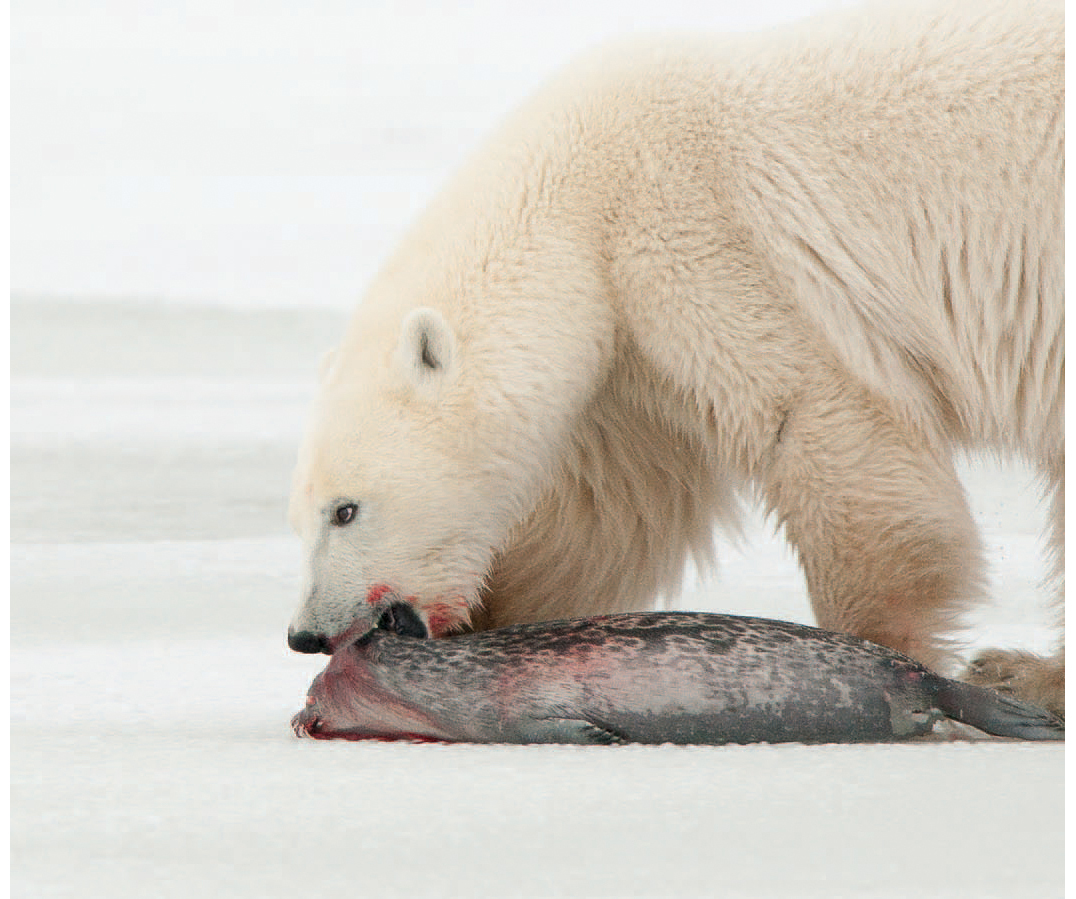
SHARING DINNER
Photo: Hugh Rose/hughrosephotography.com
Subadult Polar Bears recently separated from their mother may remain together for weeks or months. When food is plentiful, bears may feed side-by-side amicably, but the dominant cub will hog any meal during lean times.

RESTAURANT WITH A VIEW
Photo: Adam Rheborg
An adult Polar Bear feeds on a seal on one of the many ice floes scattered at the base of a large glacier. Calving glaciers provide plenty of resting spots for seals, and good cover for the bears that stalk them.

THIS KILL IS MINE
Photo: Adam Rheborg
While an adult Polar Bear feeds, a subdominant bear looks on from a distance. It is quite possible that the latter bear had made the kill but was driven off, usually without a fight. By patiently waiting for the larger bear to finish, a subdominant Polar Bear may still enjoy some leftovers.

STEALING A CATCH
Photo: Adam Rheborg
In the low light of an Arctic evening, a larger bear approaches a bear that had recently captured a seal. Bears of equal size may fight over a kill, although these altercations usually only involve posturing and teeth gnashing, and rarely physical contact. In a real fight, any injury incurred could ultimately prove fatal to either bear in an environment where one lives on a razor’s edge.

A MEAGER SNACK
Young and baby seals provide little nourishment, as their bodies still lack the energy-rich layer of blubber the bears relish, and are often left unconsumed. The meat does not go to waste, however, as Glaucous and Ivory Gulls, Arctic Foxes, and hungry bears will scavenge the remains.

RINGED SEAL
The favorite prey of the Polar Bear, Ringed Seals, when hauled out on ice, are constantly on the alert and usually within a seal’s length of an escape hole. At the first hint of danger, the seal will slip into the hole and escape . . . unless the bear is faster!

LUCKY CATCH
Photo: Richard Day
Until Hudson Bay freezes, Ringed Seals spend nearly all of their time in the water where they are safe from bears. This Polar Bear was lucky, capturing a Ringed Seal that swam too close to shore.

HUNTING PRACTICE
Photo: Hugh Rose/hughrosephotography.com
A Polar Bear subadult practices the pouncing behavior it will use to crash into the den of a Ringed Seal. In spring, Ringed Seals hollow out a birthing den beneath the snow, creating a subnivean igloo. Bears, smelling a seal inside, will pounce onto the roof of these dens, hoping to break through before the seal escapes.

THE HUNT
Photo series: Sue Altenburg
A Polar Bear pauses, smelling a concealed Ringed Seal in a den on an ice floe (1). With little warning, the bear leaps and crashes onto the roof of the den (2). The roof of the seal’s den remains intact (3). The bear makes a second effort to break into the den but the roof holds (4). The Bear reaches into the den at the water line before the seal could make its escape (5).

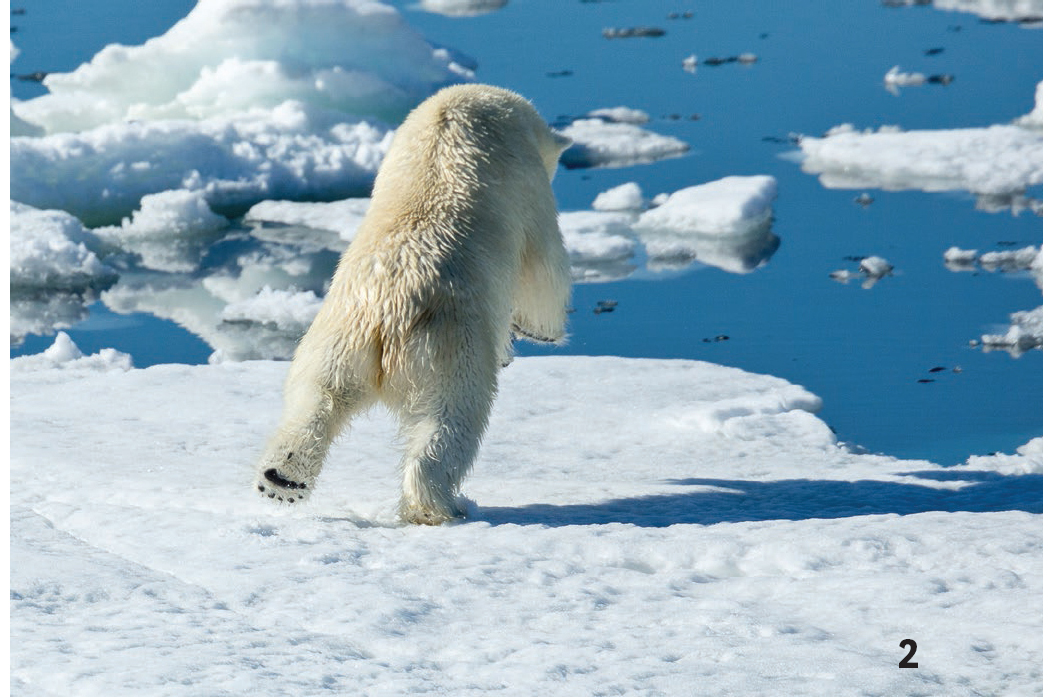



The mother bear extracts the Ringed Seal from its den while her cubs, who sat waiting quietly nearby, rush in (6). Typical of many kills, the Polar Bear carried her catch far away from the site of capture with her cubs in hot pursuit. This behavior may lessen the chance that the seal might slither back into an escape hole—certainly not the case here (7).


HARP SEAL
One of the most common of the sub-Arctic Seals, the Harp Seal is so-named because of the black lyre-shaped marking on the adult’s coat. Baby Harp Seals, like the Ringed Seal, are born white, but unlike the Ringed, babies are born right on the ice. Polar Bears occasionally devastate large Harp Seal nurseries, although this seal usually gives birth far out to sea.

SEA STEALTH
Photo: Adam Rheborg
Polar Bears hunt either by still hunting or by stalking. Stalks may begin hundreds of yards away, with the bear slowly moving forward, freezing motionless whenever a seal looks up, and using ice floes and ridges as cover as it approaches.

FINAL APPROACH
Photo: Hugh Rose/hughrosephotography.com
Some of the most exciting hunts occur when a Polar Bear approaches a seal from the water. Bears will swim under ice floes to approach unseen, then, in the final instant, rocket out of the water, surprising the seal before it can escape. Less than half the time, a bear succeeds.

BEARDED SEAL
Bearded Seals are the second most common prey item in most Polar Bear populations, but a large adult seal may weigh over 800 pounds, a very challenging catch for many female and most subadult Polar Bears. These seals feed on the mucky bottom of the sea floor, and iron oxides often stain their face and body an orange-red.

THE MUSTACHE SEAL
The prominent whiskers, or vibrissae, make identification of a Bearded Seal easy. The whiskers are on the muzzle, not the chin, so a more accurate name for this large seal would be Mustache, not Bearded, Seal.

PICKY EATER
Photo: Adam Rheborg
Polar Bears that enjoy a series of successful hunts become picky eaters, stripping the blubber from a seal carcass and leaving the rest behind. Fat provides far more energy than the protein-rich muscle, and given the chance, bears fill up their bellies with the most efficient food source.

A CLOSE CALL
The shredded rear flippers of this Bearded Seal are stark evidence of a previous encounter with a Polar Bear. These large seals are powerful animals, and by spinning and twisting, they may break the lethal grip of the bear and escape.

HARBOR SEAL
The seals are divided into two distinctive groups. Eared Seals include the Sea Lions and Fur Seals, which are not regularly found in the Polar Bear’s range. Earless Seals, also known as True Seals, include all the species found within the Polar Bear’s habitat, and include the Ringed, Bearded, and Harp Seal, among many others.

MAROONED
Photo: Adam Rheborg
When summer arrives, Polar Bears in the southern part of their range must come to land, where food is scarce. Hungry bears may go months without food, though in inhabited areas, Polar Bears may raid cabins or dumps as they seek food.

STALKING THE BEACHES
Photo: Hugh Rose/hughrosephotography.com
Bears may travel miles each day, searching the beaches for carrion. Dead seals, walruses, or whales occasionally wash ashore, and, if found, might sustain a bear or several bears for months.

POLAR BEAR & WALRUSES
Photo: Adam Rheborg
A bull walrus may weigh over 3,500 pounds and is too large for all but the largest male Polar Bear to attempt to tackle. Still, a big walrus is a tempting target for a hungry bear.
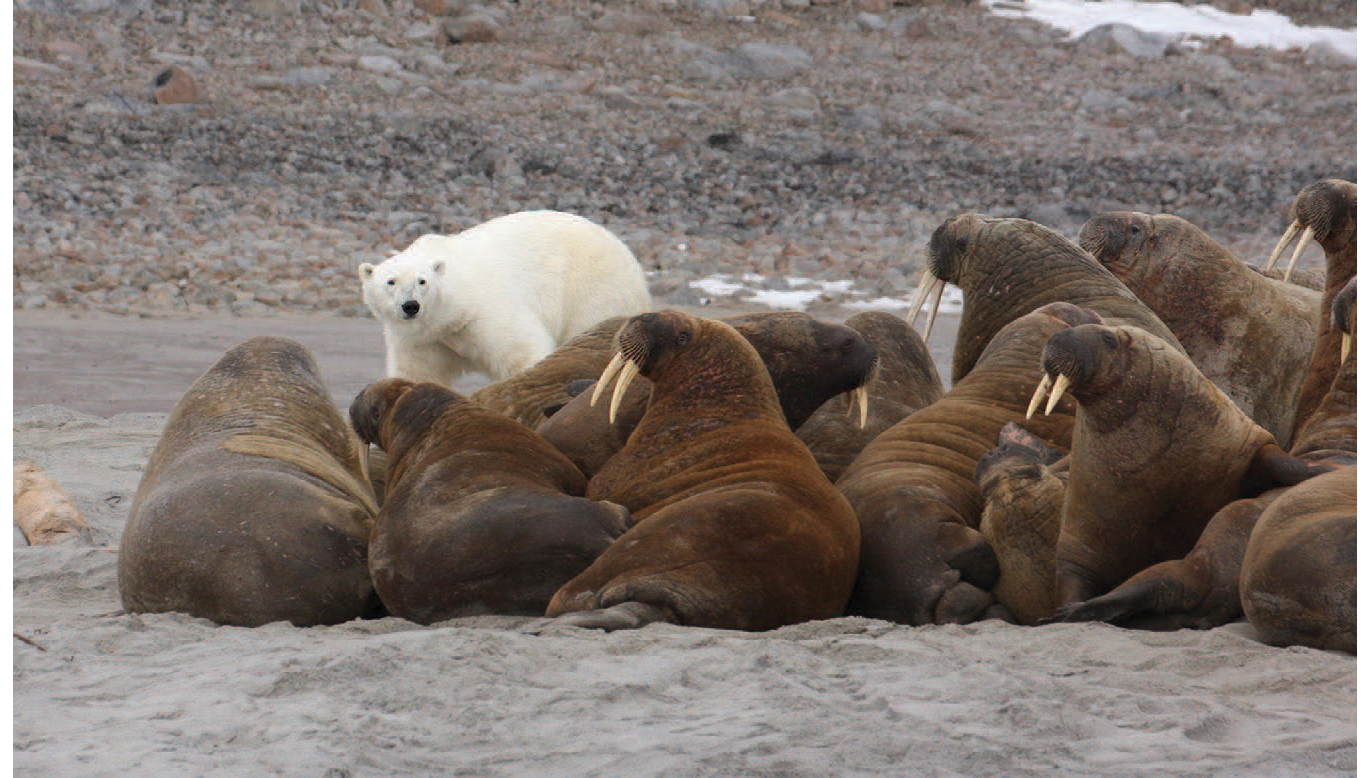
TESTING
Photo: Adam Rheborg
This Polar Bear stretches its neck out cautiously as it investigates a walrus herd that seems unconcerned by the bear’s presence. Protected by other members nearby, walruses may hold their ground, secure in their numbers.

TRIGGERING PANIC
Photo: Adam Rheborg
Bears do kill walruses on occasion, and any given herd might panic when harassed by a bear. During the walruses’ rush to the sea, calves may be killed or injured, and a bear will snatch any young walrus it can.
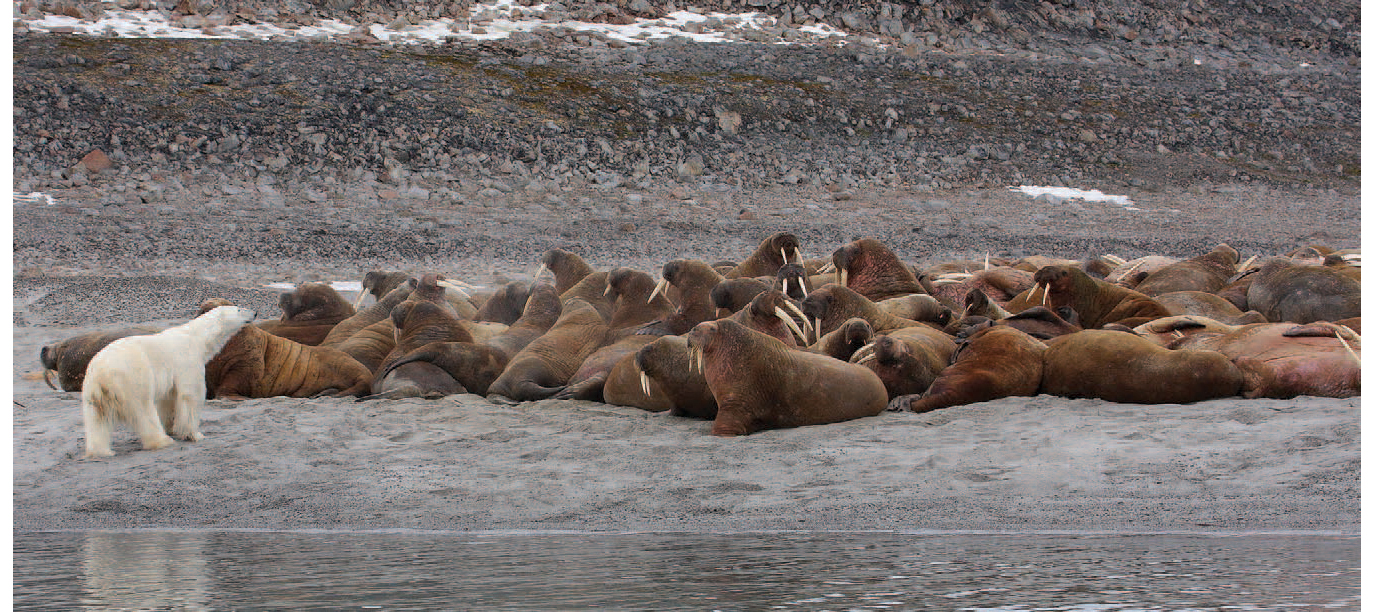
A FORMIDABLE WALL
Photo: Adam Rheborg
This walrus herd lumbered into the sea for safety, where they could now present a deadly formation of gleaming tusks. Once in the water, the advantage lies with the walrus, and Polar Bears have been killed when they unwisely proceeded with an attack.
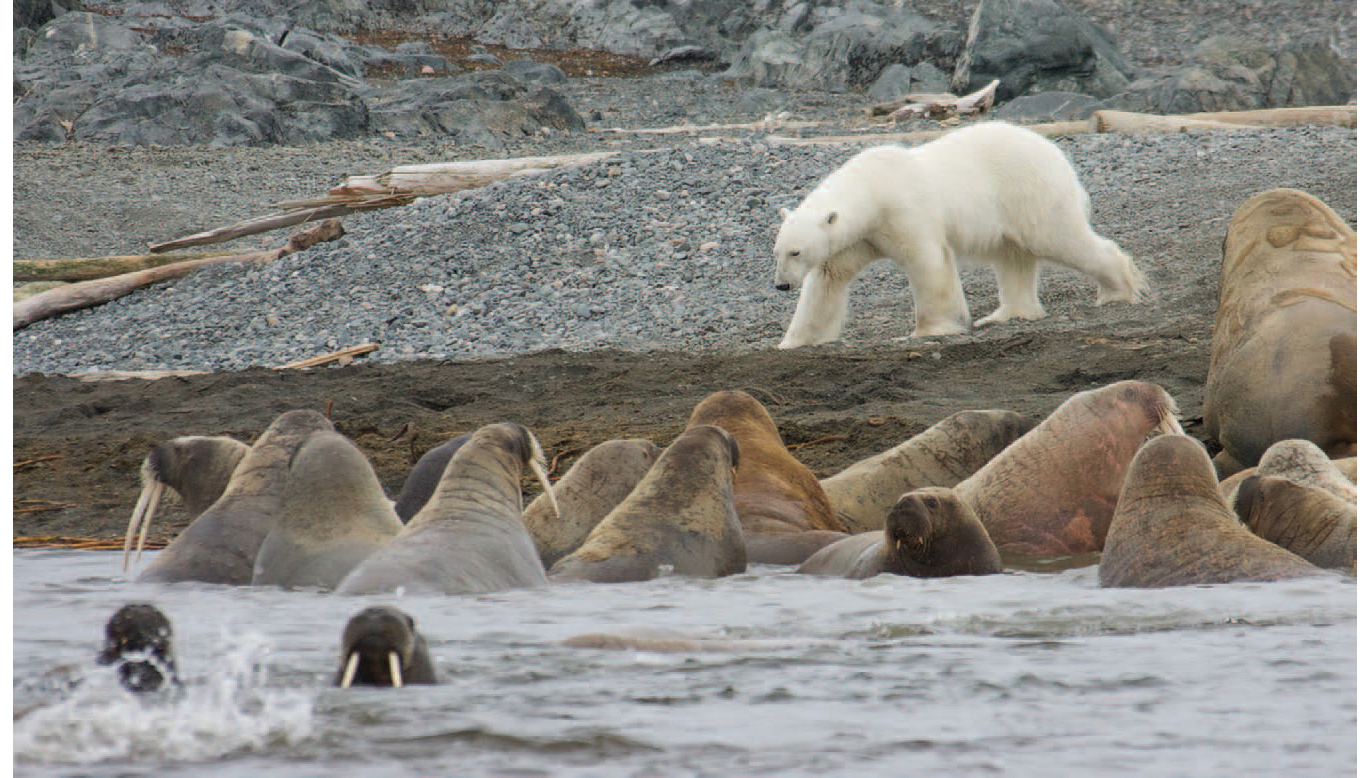
PLAYING WITH THEIR FOOD
Photo: Hugh Rose/hughrosephotography.com
A subadult Polar Bear plays with a walrus flipper that may have been from a scavenged carcass. The thick, meatless hide of this flipper offers little nourishment for a hungry bear.

DEADLY TUSKS
A male walrus’s tusks, which may reach one meter in length, are deadly defensive weapons when directed at an attacking Polar Bear. A stab may result in a crippling injury that may eventually kill the bear, if the original wound alone isn’t fatal.
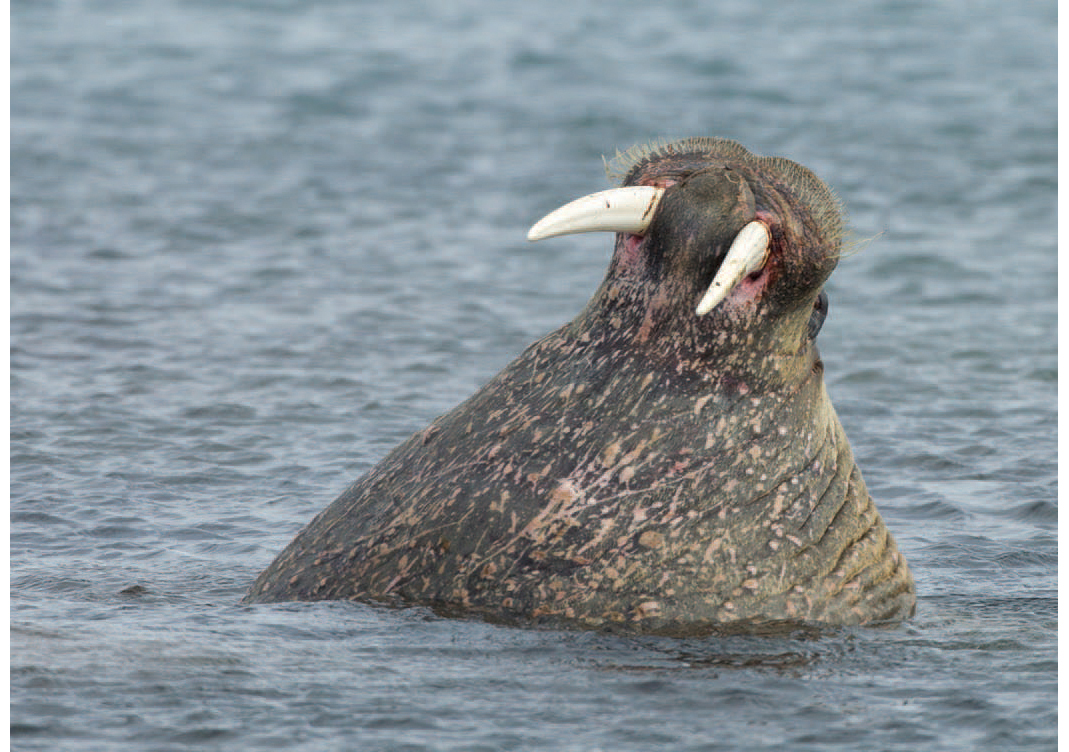
BALEEN BANQUET
Photo: Hugh Rose/hughrosephotography.com
The carcass of a Bowhead Whale may sustain dozens of Polar Bears throughout the summer. Some whales die naturally and wash up onto beaches, while this one, in northern Alaska, was killed by Inuit in a traditional hunt.

CHOPPED STEAKS
Photo: Hugh Rose/hughrosephotography.com
Ulu knives created the sharp edges on these slabs of meat and blubber from this Bowhead Whale. Whatever meat that is not used by the Inuit will be scavenged by the bears.

SHARING
Photo: Hugh Rose/hughrosephotography.com
Large numbers of Polar Bears may feed relatively amiably at a whale carcass, but such a bounty of food also attracts other scavengers, including wolves and Arctic Foxes. On Alaska’s northern coast, dead whales also attract Grizzly Bears. This aggressive species will not only displace Polar Bears from a carcass, but in a few recorded cases, Grizzlies have also mated with Polar Bears to create a hybrid called the Prizzly or Grolar Bear.
